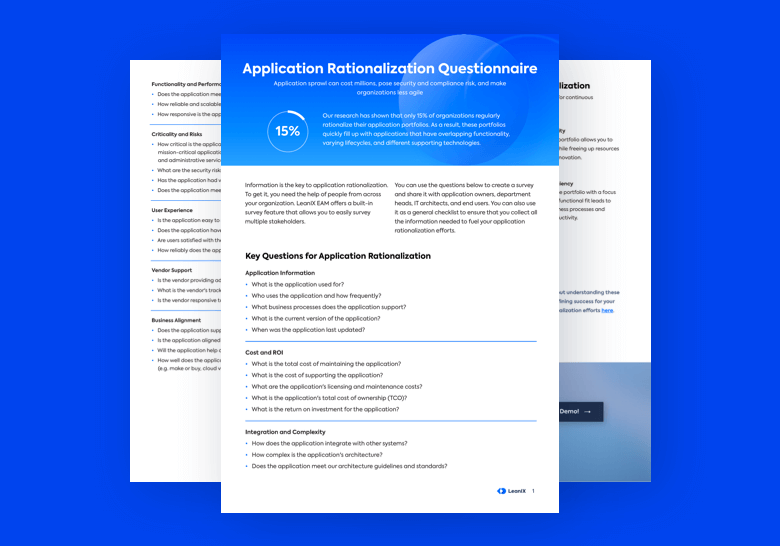[CONTINUED]
Using spreadsheets
Tracking applications using spreadsheets is only recommended for businesses with a small number of employees, departments, and applications. This is because compiling an application inventory using spreadsheets involves a lot of manual work.

Populating a spreadsheet template will involve many requests, working with stakeholders and department heads, and compiling information from a variety of sources.
The more complex the organizational structure, the more time-consuming this process will be. With a higher error chance, business decisions can be based on wrong data.
A few general steps to track application inventory using spreadsheets are:
- List the names of all applications in a new spreadsheet.
- Add information for each application (read sections below for specifics). A low-detailed spreadsheet can include columns for application type, category, department, and owner. More insightful ones can also include costs, compliance, renewal dates, usage, forecast, and total contract value.
- Ask other department heads to help you populate the spreadsheet with missing applications and information.
- Generate the reports you require. Depending on your goal, reports can be created for rationalization or IT cost optimization programs, post-merger integrations, cloud adoptions, or technology obsolescence risks.
- Continuously populate a spreadsheet with new applications.
- Extra: Implement APM or SaaS Management tools to help you build your future landscape.
If all of this seems too much to handle, let's see how to build an application portfolio automatically.
📚 Related: Assess application criticality levels
Using software
Application Portfolio Management (AMP) tools solve a lot of the problems spreadsheets create. These specialized tools track and monitor all applications within an organization’s portfolio.
Beyond AMP, SaaS management and software asset management tools can be used to track and manage specific software.

Automated application inventory means less manual work and can easily create a complete inventory. This will be the foundation for creating an application landscape that connects applications to business capabilities and business processes.
APM supports the informational needs of diverse stakeholders (CIOs, CTOs, IT managers, enterprise architects, cloud architects, and more).
LeanIX offers two application inventory software solutions to build an application inventory – LeanIX Enterprise Architecture Management (EAM) and LeanIX SaaS Management Platform (SMP).
Using either application portfolio management or SaaS management, these disciplines allow you to automatically gather and monitor applications within an organization.
What application information to include in the inventory?
When compiling an application inventory, there are several vital pieces of information to include. Besides the name and general description of what each app does, the value of application inventory can be realized when you have the following information:
- Application owner: Who owns the application within an organization?
- Category: What category of applications this particular one is part of? This comes in handy during the application rationalization process.
- Description: What does the application do? This comes in handy for IT to quickly understand what an application does, whom it affects, and how it works.
- Lifecycle of application: Is the application close to the end-of-life? Does it have to be replaced with another, etc?
- Usage: How often is the app used, and how many active users vs. the number of licenses purchased?
- Functional/business value: What value and function does the app bring to the business? How vital is it day-to-day?
- Technical value: Does the app satisfy our technical needs and can it be part of our future IT roadmap?
- Cost: Track monthly vs. annual cost. Allows for IT budgeting and forecasting.
- Pricing: Is the pricing based on users or the number of licenses?
- Compliance: I.e. is the application SOC 2 or GDPR compliant?
- Contract details: What are the start and end dates of the contract? In the case of SaaS, when is the renewal date?
- Business capability (Advanced): Which business capability is the application part of? Does the application support adequate business capability? (Use APM tool)
- Application dependencies/relationships (Advanced): Where and how does the app integrate with other apps and IT components in the portfolio? (Use APM tool)
- Target architecture (Advanced): Visualize future technology roadmap and plan which applications need replacement on a timeline. (Use APM tool)
Once and if all of these attributes have been added, IT and business leaders can make smart business decisions, supported by future technology.
📚
Related: What are mission-critical applications? and What are business-critical applications?
How does LeanIX help?
Tracking application information is the first step towards a leaner IT landscape. Our EAM tool provides users with an application portfolio management module.
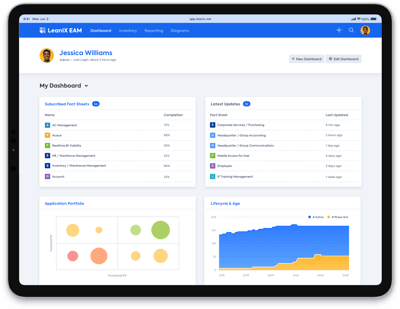
By using the application portfolio management tool, architects can:
- Reduce IT complexity and improve efficiency by removing waste and improving value.
- Promote better collaboration and create transparency between business and IT departments.
- Enable cloud native strategies for securely upgrading core IT processes according to business criticality.
- Mitigate and monitor security and compliance vulnerabilities by monitoring application lifecycles.
- Discover SaaS inventory.
- Use holistic insights to create data-driven reports which allow architects to monitor large-scale IT transformation projects.
- Rationalize applications to lower the total cost of ownership and make processes more efficient.
- See which IT projects can be prioritized based on the application landscape and business needs.
- Map data flows and application dependencies.
Conclusion
Tracking an application inventory is the first step toward creating a cost-effective and lean IT landscape.
Application portfolio management tools are designed to optimize software inventories and run application rationalization initiatives. This can only be accomplished by creating a complete and transparent application inventory.
With inventory in hand, you're now able to perform an application portfolio assessment based on your goal.
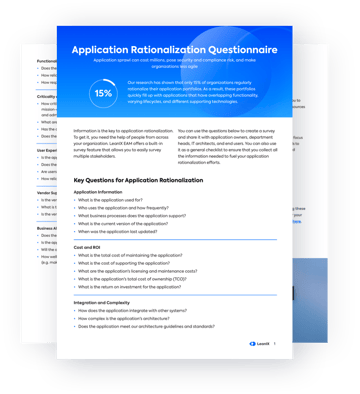
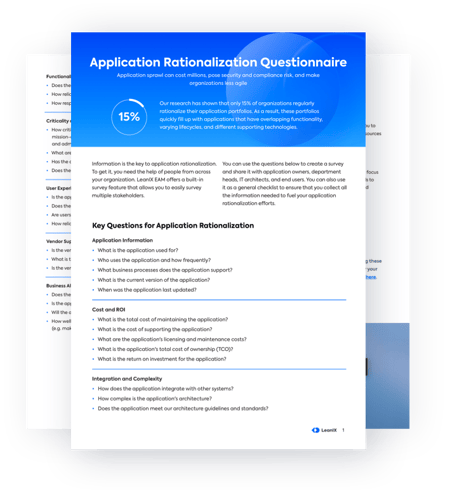

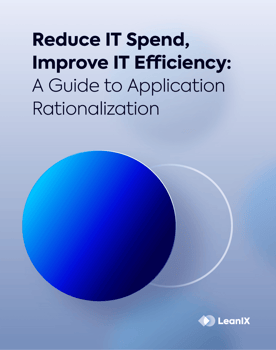
/EN/White-Paper/EN-IDC-Inforbrief-Application-Rationalization-Portfolio-Management-Thumbnail_v2.png?width=260&height=171&name=EN-IDC-Inforbrief-Application-Rationalization-Portfolio-Management-Thumbnail_v2.png)

/EN/Reports/Thumbnail-Gartner%20720x500.png?width=260&height=171&name=Thumbnail-Gartner%20720x500.png)


